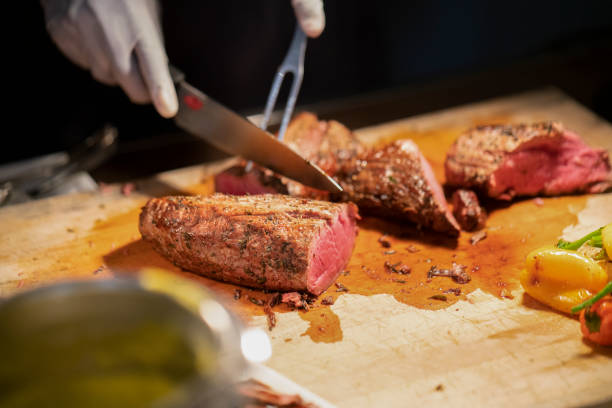Buffets offer a cornucopia of culinary delights, but perhaps one of the most captivating and mouthwatering sections is the carving station. It’s a place where skillful chefs turn whole roasts, hams, and birds into masterful slices of perfection. The sight and aroma of the carving station are enough to make anyone’s stomach rumble. In this exploration of the carving station at the buffet, we’ll delve into the history, artistry, and the sensory experience that elevates this section to a gastronomic masterpiece.
A Slice of History
The carving station is not a recent invention; its roots can be traced back to medieval feasts and Renaissance banquets. In these grand affairs, roasted meats were a symbol of opulence and extravagance, and skilled carvers were highly esteemed. Guests would gather around, admiring the precision and finesse of the carver as they transformed a whole animal into perfectly sliced portions.
The Buffet Revolution
The concept of the modern buffet, with its array of dishes and the carving station, was popularized in Sweden during the 18th century. The word “buffet” itself has French origins, meaning “sideboard” or “counter.” However, it was the Swedes who transformed it into a self-service feast, and it soon spread to other parts of Europe and the world.
The Art of Carving
The carving station is where culinary artistry and gastronomic pleasure converge. Here’s why it’s so much more than a place to get your meat:
Precision and Skill
The art of carving involves precision and technique. A skilled carver can slice meat so thinly that it melts in your mouth, creating an unforgettable dining experience.
Showmanship
Watching a chef carve meat can be a mesmerizing experience. It’s a performance, with the carver as the star, wielding their knife with grace and flair.
Customization
At the carving station, you can request the exact portion you desire, from rare to well-done. It’s an opportunity for a customized dining experience.
Freshness
The carving station ensures the meat is carved fresh for each guest, preserving its juiciness and flavor. There’s no compromise on quality.
Variety
The carving station isn’t limited to one type of meat. You can often find a selection of roasts, hams, turkeys, and more, allowing you to sample an assortment of flavors.
The Sensory Experience
The carving station stimulates multiple senses, making it a feast for more than just your taste buds:
Sight
The visual appeal of a beautifully presented carving station is undeniable. The glistening, perfectly sliced meats are a feast for the eyes.
Aroma
As you approach the carving station, the aroma of roasting meats wafts through the air, tempting your senses and building anticipation.
Sound
The subtle sounds of carving, the gentle scrape of the knife against the meat, are a part of the experience. It’s the siren song of succulence.
Taste
Finally, the moment you’ve been waiting for. The first bite, cooked to perfection, rewards your palate with an explosion of flavor.
Beyond Meat
While meat is the star of the carving station, it’s not the only attraction. Many carving stations offer accompaniments to enhance the dining experience. Some examples include:
Sauces
A selection of sauces, from rich gravies to tangy mustards, complements the meat, adding layers of flavor.
Side Dishes
Carved meats are often paired with a variety of side dishes, such as mashed potatoes, vegetables, and freshly baked bread.
Presentation
The carving station is an opportunity for creative presentation. Chefs often garnish the dishes with fresh herbs, fruits, and colorful vegetables, making it a work of art.
The Global Influence
Carving stations can be found in various forms around the world. While the meats and techniques may differ, the essence remains the same: to provide guests with a memorable dining experience.
Here are a few examples:
Prime Rib in the United States
In the U.S., prime rib is a popular carving station choice. It’s often served with au jus and creamy horseradish sauce.
Suckling Pig in Spain
Lechazo, or suckling pig, is a Spanish delicacy often slow-roasted and carved with precision.
Peking Duck in China
Peking duck is a beloved dish that involves thin slices of roasted duck served with thin pancakes, hoisin sauce, and julienned scallions.
Rotisserie Chicken in France
In France, the rotisserie chicken is a common sight at markets and buffets, with its golden, crispy skin and tender meat.
Gyros in Greece
The rotating vertical spits of gyros shops are a culinary spectacle. Slices of flavorful, seasoned meat are shaved off and served in pita bread with various accompaniments.
A Culinary Journey
The carving station is more than a place to get your food; it’s a culinary journey. It’s a tribute to tradition, skill, and the sensory delight of dining. Whether you’re at a lavish banquet or a cozy Sunday brunch, the carving station elevates the buffet experience to an art form that’s meant to be savored, slice by delicious slice.
